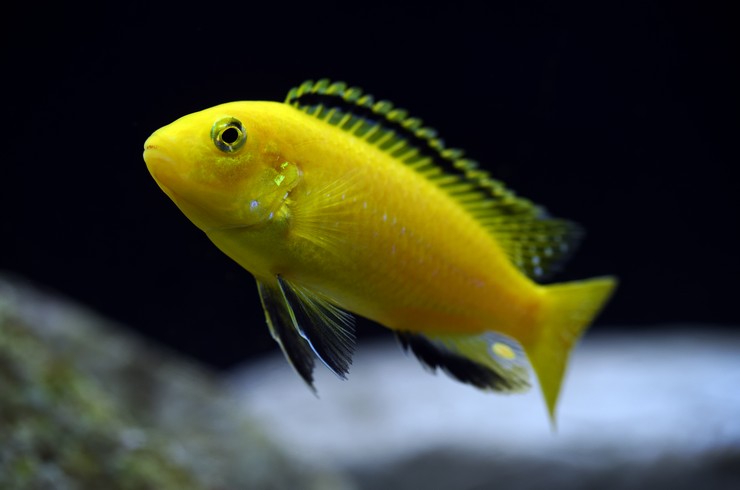Fish with a bright and juicy color always attracts aquarists, because they instantly attract the eye. Among the cichlids of Lake Malawi, there are many species with amazing colors, but if you want to have something bright and sunny, then the labidochromis Yellow is the best choice. The striking contrast of lemon color and black stripes on the fins cannot leave you indifferent. In addition, this species is relatively peaceful and unpretentious in content.
General information
Labidochromis Yellow (Labidochromis caeruleus var. “Yellow”) is a freshwater tropical fish from the Tsikhlov family. It lives in Lake Malawi and belongs to the Mbuna group. Translated from the language of the natives, this word means “fish living in the rocks”, which well reflects the ecological characteristics of this group of fish. After all, labidochromis live along the rocky shores of the lake, arrange shelters in crevices.
Labidochromis Yellow, hummingbird cichlid, lemon labidochromis – this is not a complete list of the names of this interesting fish, indicating to us a small body size and color features relative to other cichlids. In nature, there are several color options, but it is the lemon yellow fish that have become the most popular.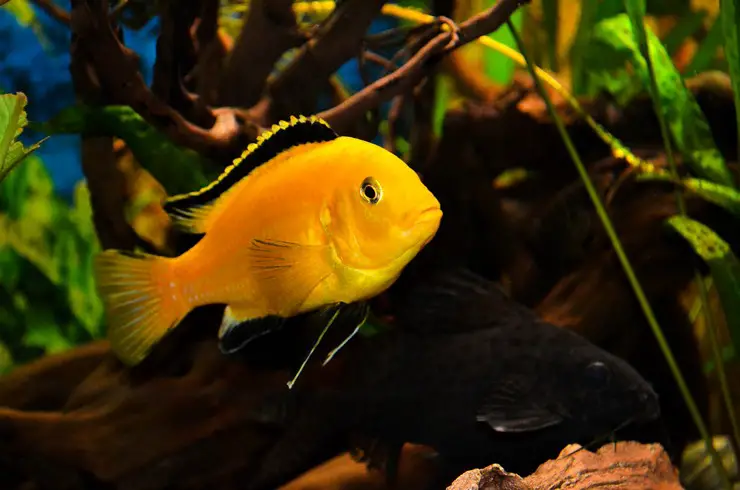
Compared to other representatives of the Mbuna group, Yellow’s labidochromis is the least aggressive species and is often able to get along with many even medium-sized fish. Aggression in fish wakes up only during the spawning period and sometimes when kept with species similar in color because they seem to be direct rivals to males.
Yellow’s labidochromis is unpretentious in maintenance and, perhaps, will be the best choice for those aquarists who, for the first time in their life, decided to have Mbuna Malawians.
Appearance
Yellow’s labidochromis has the typical body shape characteristic of many cichlids of Lake Malawi: elongated, streamlined, slightly flattened from the sides. The size of individuals caught in nature does not exceed 8 cm, but in aquariums, a hummingbird cichlid can grow up to 10 cm. However, these are not at all large representatives of the cichlid family, for which the fish received the species name in honor of the smallest bird on the planet.
In natural conditions, there are more than 10 color variations of hummingbird labidochromis, but the most popular is the yellow forms. The adult body has a uniform lemon yellow color that contrasts with a wide black border on the dorsal and anal fins and dark pectoral fins. A dark streak also goes through the eye. Males may also show oval orange spots on the anal fin.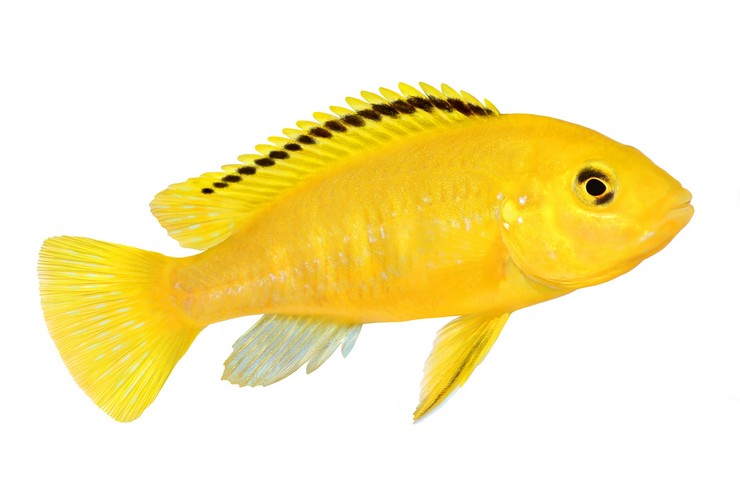
Gender dimorphism is not pronounced. The dominant male is quite easy to calculate – he has the brightest color and well-developed fins. Females and subdominant males are colored more modestly and are practically indistinguishable from each other. Juveniles also have a pale coloration, which only increases with age.
Habitat
We owe this stunning bright cichlid to our aquariums to Lake Malawi in Africa. In it, labidochromis are very widespread. Individuals with yellow color are found mainly off the northwest coast.
The fish keep near rocky shores at depths of 10 to 30 meters. They live in pairs or singly. Hummingbird cichlids do not differ in pronounced territoriality.
Care and maintenance
For the comfortable existence of Yellow’s labidochromis, you need an aquarium of 100 liters or more. This volume is enough to accommodate one male and three or four females. Do not place several males in one aquarium, as fierce fights can occur between them.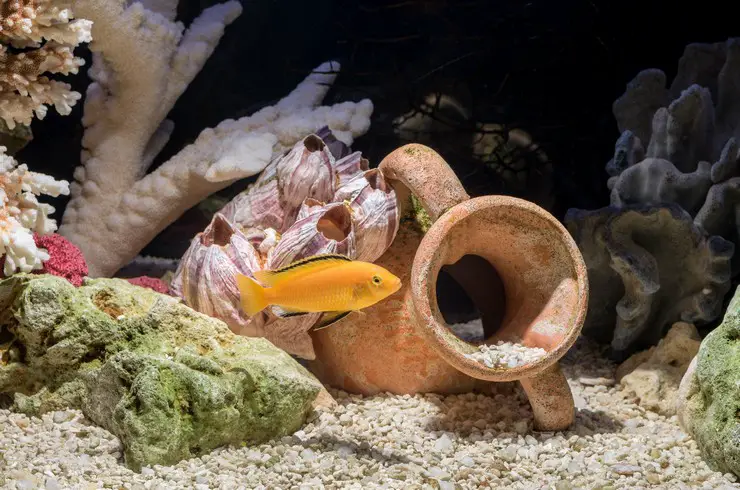
It is best to design an aquarium in the style typical of Malawian cichlids: sandy soil, a large number of stones and snags, from which multiple shelters are created, and a minimum amount of living plants (best of all, hard-leaved).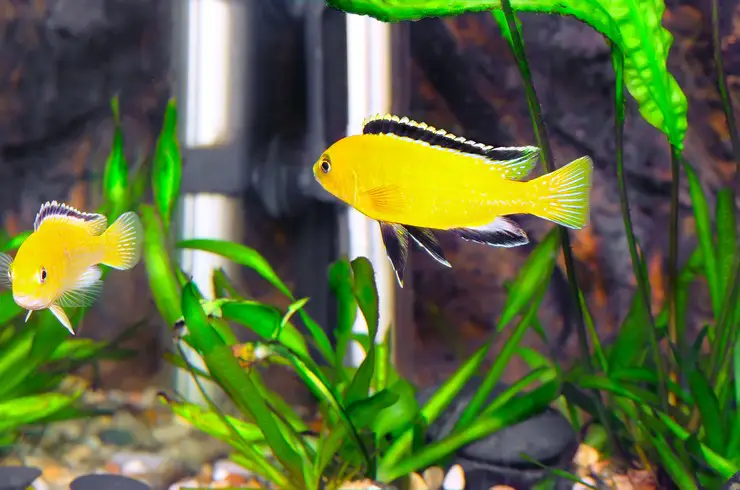
Like other cichlids, labidochromis are sensitive to the high content of nitrogenous compounds in water. Therefore, the aquarium must be equipped with a powerful external filter and a powerful compressor. Water changes are required once a week (up to 20% of the aquarium volume) and a soil siphon.
Compatibility
Yellow’s Labidochromis is distinguished by its mild character. The manifestation of aggression towards other species in a common aquarium is quite a rare phenomenon, often the fish do not even notice their neighbors, but are entirely occupied by their relatives. It is noted that problems in keeping arise only when combining fish with a similar color; this point should be taken into account when selecting cohabitants.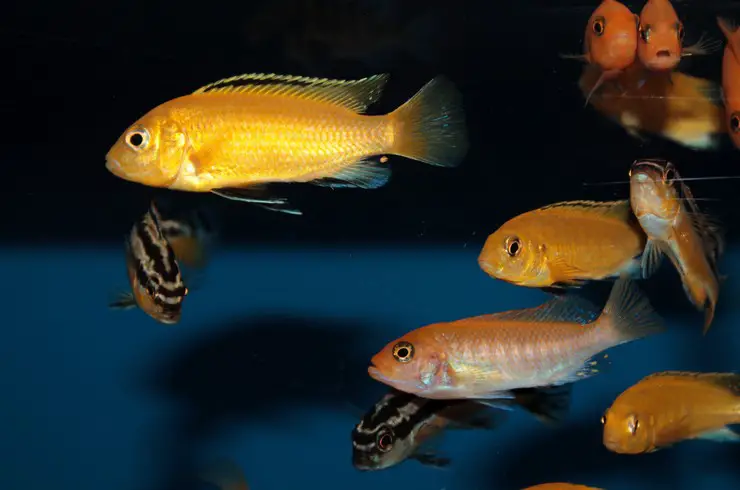
Comparable Malawian cichlids – pseudotrophies, melanochromis, etc. – will become the best neighbors for lemon labidochromis. However, the fish are well combined with other medium and large species: labeo, battles, iris, ancistrus. In a spacious aquarium, along with a hummingbird cichlid, you can keep cynodonts or pterygoplichts.
Very small fish and forms with veil fins should be excluded from possible cohabitants. They can fall prey to brightly colored cichlids or be bitten.
Feeding Labidochromis Yellow
Labidochromis Yellow belongs to the omnivorous species. The natural diet of the fish is represented by insects, algae, mollusks, and small crustaceans. Cichlids have a series of small, pointed teeth that they use like tweezers, allowing them to reach their prey from small cracks in rocks. This feature is reflected in the Latin name of the genus because “libidos” is translated from Greek as “tweezers”.
Feeding hummingbird cichlids at home is not difficult, they perfectly eat high-quality dry food. It is important not to make up a diet of labidochromis exclusively from protein products in the form of live and frozen food – sooner or later this will lead to gastrointestinal diseases. Not to mention the likelihood of introducing infection or parasites into the aquarium.
It is best to use complete feeds for feeding, which will include algae:
- Tetra Malawi is specially formulated for the Mbuna group of Malawian cichlids. Produced in the form of flakes and granules, 40% consists of algae (spirulina, nori, chlorella). Fully satisfies the nutritional needs of herbivorous cichlids.
- Tetra Cichlid Algae Mini is a pellet food containing spirulina. It is highly edible and fully provides labidochromis with all nutrients.
- Tetra Cichlid Color contains natural carotenoids to enhance the color of your fish and make them even more attractive.
- TetraPro Algae is also perfect for labidochromis, as the highly nutritious chips contain a concentrate of spirulina algae in the center.
And, of course, don’t forget to pamper your pets with delicious natural treats from the Tetra FreshDelica series. Bloodworms or brine shrimp in nutritious jelly will perfectly diversify the diet of your fish.
It is recommended to feed Labidochromis 2-3 times a day in small portions (which will be completely eaten within 2-3 minutes) and not to overeat.
Reproduction and breeding
Labidochromis Yellow is considered one of the easiest species to breed. By and large, there is no need to create special conditions to obtain offspring. Fish reproduce easily in a shared aquarium.
Gender dimorphism is not expressed. Males are slightly larger and have a more intense coloration. Puberty occurs at the age of 7-8 months.
The male usually prepares the place for future spawning. He digs a hole or clears a rock in a secluded place. The fecundity of a female can be up to 30 eggs. After fertilization, the female takes the eggs into the mouth, keeping them in a special throat bag. Here the eggs develop within 25-40 days. All this time, the female refuses to eat. Fry care continues even after hatching. The size of newborns is 2-3 mm, they are already capable of self-feeding. In the general aquarium, it is necessary to have shelters so that the neighbors of labidochromis do not feast on juveniles.